Books Click on the image to take you directly to the publisher’s website where you can purchase your choice
We have written and edited many books on Human Factors over the past 20 years, as can be seen below... |
| Click to return to Books/Articles |
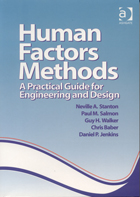 Human Factors Methods: A Practical Guide for Engineering and Design presents more than ninety design and evaluation methods, and is designed to act as an ergonomics methods manual, aiding both students and practitioners. The eleven sections of the book represent the different categories of ergonomics methods and techniques that can be used in the evaluation and design process. Human Factors Methods: A Practical Guide for Engineering and Design presents more than ninety design and evaluation methods, and is designed to act as an ergonomics methods manual, aiding both students and practitioners. The eleven sections of the book represent the different categories of ergonomics methods and techniques that can be used in the evaluation and design process. |
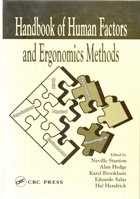 Research suggests that ergonomists tend to restrict themselves to two or three of their favorite methods in the design of systems, despite a multitude of variations in the problems that they face. Human Factors and Ergonomics Methods delivers an authoritative and practical account of methods that incorporate human capabilities and limitations, environmental factors, human-machine interaction, and other factors into system design. The Handbook describes 83 methods in a standardized format, promoting the use of methods that may have formerly been unfamiliar to designers. Research suggests that ergonomists tend to restrict themselves to two or three of their favorite methods in the design of systems, despite a multitude of variations in the problems that they face. Human Factors and Ergonomics Methods delivers an authoritative and practical account of methods that incorporate human capabilities and limitations, environmental factors, human-machine interaction, and other factors into system design. The Handbook describes 83 methods in a standardized format, promoting the use of methods that may have formerly been unfamiliar to designers. |
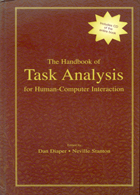 A comprehensive review of the current state of research and use of task analysis for Human-Computer Interaction (HCI), this multi-authored and diligently edited handbook offers the best reference source available on this diverse subject whose foundations date to the turn of the last century. A comprehensive review of the current state of research and use of task analysis for Human-Computer Interaction (HCI), this multi-authored and diligently edited handbook offers the best reference source available on this diverse subject whose foundations date to the turn of the last century. |
 This book places Human Factors firmly at the centre of good product design. The approach is amply illustrated though a variety of case studies in design of consumer products. This book places Human Factors firmly at the centre of good product design. The approach is amply illustrated though a variety of case studies in design of consumer products. |
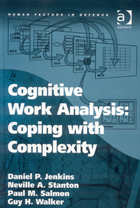 Cognitive Work Analysis offers a comprhesive framework for considering the development and evaluation of complex socio-technical systems. The approach models constraints acting upon systems Cognitive Work Analysis offers a comprhesive framework for considering the development and evaluation of complex socio-technical systems. The approach models constraints acting upon systems |
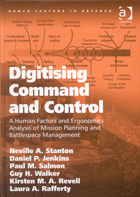 A Human Factors and Ergonomics analysis of a new digital system is presented through a variety of interconnected analyses of tasks and system functions. Extensive observations and interviews were collected for analysis through a case study approach within the field. A Human Factors and Ergonomics analysis of a new digital system is presented through a variety of interconnected analyses of tasks and system functions. Extensive observations and interviews were collected for analysis through a case study approach within the field. |
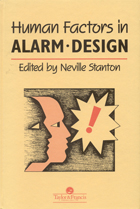 Human Factors in Alarm Design makes it clear the enormous contribution ergonomics thinking has on the design of alarm displays in a variety of settings - such as nuclear, oil, chemical, conventional power, automotive and medical. Human Factors in Alarm Design makes it clear the enormous contribution ergonomics thinking has on the design of alarm displays in a variety of settings - such as nuclear, oil, chemical, conventional power, automotive and medical. |
 A Chinese version of the Human Factors in Consumer Products book that places Human Factors firmly at the centre of good product design. The approach is amply illustrated though a variety of case studies in design of consumer products. A Chinese version of the Human Factors in Consumer Products book that places Human Factors firmly at the centre of good product design. The approach is amply illustrated though a variety of case studies in design of consumer products. |
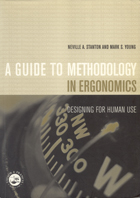 This book describes a range of methods that can be used to help design more usable interfaces. Along with the methods, evidence for their reliability and validity are presented. The costs and benefits of each of the methods is assessed through a n industrial case study. This book describes a range of methods that can be used to help design more usable interfaces. Along with the methods, evidence for their reliability and validity are presented. The costs and benefits of each of the methods is assessed through a n industrial case study. |
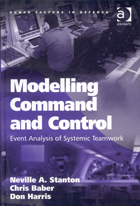 This book explores the similarities and differences in command and control in a variety of domains. Humans are places at the centre of these systems, and extensive case study material reveals the implications for design. This book explores the similarities and differences in command and control in a variety of domains. Humans are places at the centre of these systems, and extensive case study material reveals the implications for design. |
 Human Factors in Nuclear Safety shows the considerable contribution that is made by the discipline in terms of system design, selection, procedures, training, simulation, performance, shiftworking and safety culture. Human Factors in Nuclear Safety shows the considerable contribution that is made by the discipline in terms of system design, selection, procedures, training, simulation, performance, shiftworking and safety culture. |
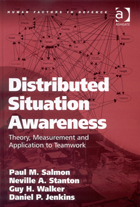 Having an understanding of 'what is going on' is a key comodity for high performing teams. Distributed Situation Awareness shows how the perspective offers a superior understanding of how joint human technology cognitive systems interact. Having an understanding of 'what is going on' is a key comodity for high performing teams. Distributed Situation Awareness shows how the perspective offers a superior understanding of how joint human technology cognitive systems interact. |
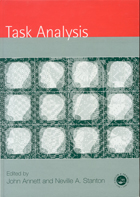 Methods of collecting, classifying and interpreting data on human performance lie at the very root of Human Factors and Ergonomics. This book reports on those methods collectively know as Task Analysis. Methods of collecting, classifying and interpreting data on human performance lie at the very root of Human Factors and Ergonomics. This book reports on those methods collectively know as Task Analysis. |
 This book provides answers to many of the problems associated with the design of auditory warnings. Application domains include air traffic control, aviation, emergency services, manufacturing, medicine, military and nuclear power. This book provides answers to many of the problems associated with the design of auditory warnings. Application domains include air traffic control, aviation, emergency services, manufacturing, medicine, military and nuclear power. |
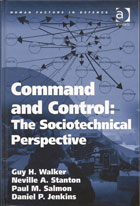 The sociotechnical perspective transforms a set of abstract principles for system design into easy examples, design guidance and evaluation criteria. These are based on extensive experience and insights generated from field studies into real systems. Time and again we find that it is people that most valuable system asset. The sociotechnical perspective transforms a set of abstract principles for system design into easy examples, design guidance and evaluation criteria. These are based on extensive experience and insights generated from field studies into real systems. Time and again we find that it is people that most valuable system asset. |
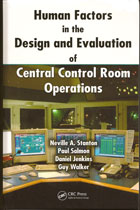 The twin demands of remote and continuous operation place special considerations on the design of central control rooms. This book provides an analysis of Human Factors and Ergonomics in this complex area and the implications for control room staff. The twin demands of remote and continuous operation place special considerations on the design of central control rooms. This book provides an analysis of Human Factors and Ergonomics in this complex area and the implications for control room staff. |
 During the course of any sporting event, critical cognitive and physical tasks are performed within a dynamic, complex, collaborative system comprising multiple humans and artefacts, under pressurized, complex, and rapidly changing conditions. During the course of any sporting event, critical cognitive and physical tasks are performed within a dynamic, complex, collaborative system comprising multiple humans and artefacts, under pressurized, complex, and rapidly changing conditions. |

To order this book, click on the cover of the book and scroll to the bottom of the 'Courses' screen. The book appears just above the Singing Bowl. Click "buy now" and proceed through to the order screen. |



 Human Factors Methods: A Practical Guide for Engineering and Design presents more than ninety design and evaluation methods, and is designed to act as an ergonomics methods manual, aiding both students and practitioners. The eleven sections of the book represent the different categories of ergonomics methods and techniques that can be used in the evaluation and design process.
Human Factors Methods: A Practical Guide for Engineering and Design presents more than ninety design and evaluation methods, and is designed to act as an ergonomics methods manual, aiding both students and practitioners. The eleven sections of the book represent the different categories of ergonomics methods and techniques that can be used in the evaluation and design process.  Research suggests that ergonomists tend to restrict themselves to two or three of their favorite methods in the design of systems, despite a multitude of variations in the problems that they face. Human Factors and Ergonomics Methods delivers an authoritative and practical account of methods that incorporate human capabilities and limitations, environmental factors, human-machine interaction, and other factors into system design. The Handbook describes 83 methods in a standardized format, promoting the use of methods that may have formerly been unfamiliar to designers.
Research suggests that ergonomists tend to restrict themselves to two or three of their favorite methods in the design of systems, despite a multitude of variations in the problems that they face. Human Factors and Ergonomics Methods delivers an authoritative and practical account of methods that incorporate human capabilities and limitations, environmental factors, human-machine interaction, and other factors into system design. The Handbook describes 83 methods in a standardized format, promoting the use of methods that may have formerly been unfamiliar to designers. A comprehensive review of the current state of research and use of task analysis for Human-Computer Interaction (HCI), this multi-authored and diligently edited handbook offers the best reference source available on this diverse subject whose foundations date to the turn of the last century.
A comprehensive review of the current state of research and use of task analysis for Human-Computer Interaction (HCI), this multi-authored and diligently edited handbook offers the best reference source available on this diverse subject whose foundations date to the turn of the last century. This book places Human Factors firmly at the centre of good product design. The approach is amply illustrated though a variety of case studies in design of consumer products.
This book places Human Factors firmly at the centre of good product design. The approach is amply illustrated though a variety of case studies in design of consumer products. Cognitive Work Analysis offers a comprhesive framework for considering the development and evaluation of complex socio-technical systems. The approach models constraints acting upon systems
Cognitive Work Analysis offers a comprhesive framework for considering the development and evaluation of complex socio-technical systems. The approach models constraints acting upon systems A Human Factors and Ergonomics analysis of a new digital system is presented through a variety of interconnected analyses of tasks and system functions. Extensive observations and interviews were collected for analysis through a case study approach within the field.
A Human Factors and Ergonomics analysis of a new digital system is presented through a variety of interconnected analyses of tasks and system functions. Extensive observations and interviews were collected for analysis through a case study approach within the field. Human Factors in Alarm Design makes it clear the enormous contribution ergonomics thinking has on the design of alarm displays in a variety of settings - such as nuclear, oil, chemical, conventional power, automotive and medical.
Human Factors in Alarm Design makes it clear the enormous contribution ergonomics thinking has on the design of alarm displays in a variety of settings - such as nuclear, oil, chemical, conventional power, automotive and medical.  A Chinese version of the Human Factors in Consumer Products book that places Human Factors firmly at the centre of good product design. The approach is amply illustrated though a variety of case studies in design of consumer products.
A Chinese version of the Human Factors in Consumer Products book that places Human Factors firmly at the centre of good product design. The approach is amply illustrated though a variety of case studies in design of consumer products.  This book describes a range of methods that can be used to help design more usable interfaces. Along with the methods, evidence for their reliability and validity are presented. The costs and benefits of each of the methods is assessed through a n industrial case study.
This book describes a range of methods that can be used to help design more usable interfaces. Along with the methods, evidence for their reliability and validity are presented. The costs and benefits of each of the methods is assessed through a n industrial case study. This book explores the similarities and differences in command and control in a variety of domains. Humans are places at the centre of these systems, and extensive case study material reveals the implications for design.
This book explores the similarities and differences in command and control in a variety of domains. Humans are places at the centre of these systems, and extensive case study material reveals the implications for design. Human Factors in Nuclear Safety shows the considerable contribution that is made by the discipline in terms of system design, selection, procedures, training, simulation, performance, shiftworking and safety culture.
Human Factors in Nuclear Safety shows the considerable contribution that is made by the discipline in terms of system design, selection, procedures, training, simulation, performance, shiftworking and safety culture. Having an understanding of 'what is going on' is a key comodity for high performing teams. Distributed Situation Awareness shows how the perspective offers a superior understanding of how joint human technology cognitive systems interact.
Having an understanding of 'what is going on' is a key comodity for high performing teams. Distributed Situation Awareness shows how the perspective offers a superior understanding of how joint human technology cognitive systems interact. Methods of collecting, classifying and interpreting data on human performance lie at the very root of Human Factors and Ergonomics. This book reports on those methods collectively know as Task Analysis.
Methods of collecting, classifying and interpreting data on human performance lie at the very root of Human Factors and Ergonomics. This book reports on those methods collectively know as Task Analysis.  This book provides answers to many of the problems associated with the design of auditory warnings. Application domains include air traffic control, aviation, emergency services, manufacturing, medicine, military and nuclear power.
This book provides answers to many of the problems associated with the design of auditory warnings. Application domains include air traffic control, aviation, emergency services, manufacturing, medicine, military and nuclear power.  The sociotechnical perspective transforms a set of abstract principles for system design into easy examples, design guidance and evaluation criteria. These are based on extensive experience and insights generated from field studies into real systems. Time and again we find that it is people that most valuable system asset.
The sociotechnical perspective transforms a set of abstract principles for system design into easy examples, design guidance and evaluation criteria. These are based on extensive experience and insights generated from field studies into real systems. Time and again we find that it is people that most valuable system asset.  The twin demands of remote and continuous operation place special considerations on the design of central control rooms. This book provides an analysis of Human Factors and Ergonomics in this complex area and the implications for control room staff.
The twin demands of remote and continuous operation place special considerations on the design of central control rooms. This book provides an analysis of Human Factors and Ergonomics in this complex area and the implications for control room staff. During the course of any sporting event, critical cognitive and physical tasks are performed within a dynamic, complex, collaborative system comprising multiple humans and artefacts, under pressurized, complex, and rapidly changing conditions.
During the course of any sporting event, critical cognitive and physical tasks are performed within a dynamic, complex, collaborative system comprising multiple humans and artefacts, under pressurized, complex, and rapidly changing conditions. 